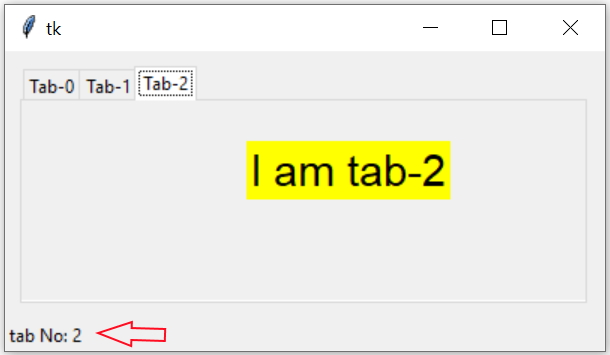<<NotebookTabChanged>> Event on Chage of tab

Tkinter Notebook methods to select hide forget tabs and using notebook tab change event
We can display the tab number at the footer of the window. Once the tab is changed then we can bind the event to trigger a function to read the tab_id by select() method and then getting the index of the tab by using index() method.
We can execute the function by using virtual event.
my_tabs.bind('<<NotebookTabChanged>>',my_msg)my_tabs.select() returns the tab_id of the current tab. Then same is used as input to my_tabs.index() to get the tab number as integer. The function str() is used to convert the number into string before displaying at Label l4.
def my_msg(*args):
t_nos=str(my_tabs.index(my_tabs.select()))
l4.config(text='tab No: '+ t_nos)import tkinter as tk
from tkinter import *
from tkinter import ttk
my_w = tk.Tk()
my_w.geometry("400x200")
my_tabs = ttk.Notebook(my_w,padding=10) # declaring
tab0 = ttk.Frame(my_tabs)
tab1 = ttk.Frame(my_tabs)
tab2 = ttk.Frame(my_tabs)
my_tabs.add(tab0, text ='Tab-0') # adding tab
my_tabs.add(tab1, text ='Tab-1') # adding tab
my_tabs.add(tab2, text ='Tab-2') # adding tab
my_tabs.pack(expand = 1, fill ="both")
font1=('time',22,'normal')
l1=tk.Label(tab0,text='I am tab-0',bg='yellow',font=font1)
l1.place(relx=0.4,rely=0.2) # using place
l2=tk.Label(tab1,text='I am tab-1',bg='yellow',font=font1)
l2.place(relx=0.4,rely=0.2) # using grid
l3=tk.Label(tab2,text='I am tab-2',bg='yellow',font=font1)
l3.place(relx=0.4,rely=0.2) # using place
def my_msg(*args):
t_nos=str(my_tabs.index(my_tabs.select()))
l4.config(text='tab No: '+ t_nos)
my_tabs.bind('<<NotebookTabChanged>>',my_msg)
l4=tk.Label(my_w,text='message here')
l4.pack(side=LEFT)
my_w.mainloop() # Keep the window openNotebook
Tab option state sticky underline image
hide() forget() and select() Methods

Subhendu Mohapatra
Author
🎥 Join me live on YouTubePassionate about coding and teaching, I publish practical tutorials on PHP, Python, JavaScript, SQL, and web development. My goal is to make learning simple, engaging, and project‑oriented with real examples and source code.
Subscribe to our YouTube Channel here
This article is written by plus2net.com team.
https://www.plus2net.com

 Python Video Tutorials
Python Video Tutorials